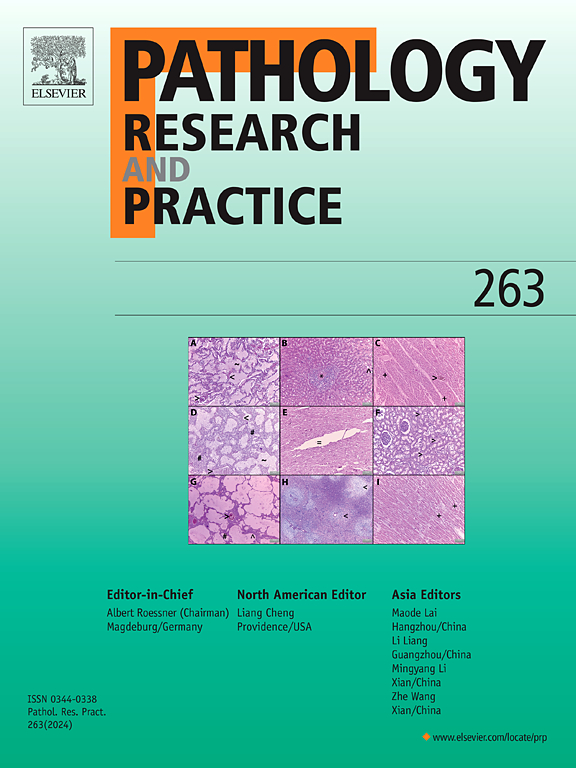Higher serum cystatin C and matrix metalloproteinase 9 levels effectively predict in-stent restenosis after stent implantation for intracranial and extracranial arterial stenosis
IF 2.9
4区 医学
Q2 PATHOLOGY
引用次数: 0
Abstract
Objective
This paper was performed to unravel the predictive value of serum cystatin C (Cys C) and matrix metalloproteinase 9 (MMP-9) levels before vascular stent implantation for in-stent restenosis (ISR) 6–12 months after stent implantation for intracranial and extracranial arterial stenosis.
Methods
One hundred and ninety-eight patients who underwent dilatation stenting for intracranial and extracranial arterial stenosis and completed Digital Subtraction Angiography or head and neck CT- Angiography review were selected for the study and were divided into ISR group (n = 33) and no ISR (NISR) group (n = 165) according to the presence or absence of ISR. Serum levels of Cys C, MMP-9, triglycerides (TG), low-density lipoprotein cholesterol (LDL-C), high-density lipoprotein cholesterol (HDL-C), uric acid (UA), creatinine (Cr), homocysteine (Hcy), fibrinogen (FIB), total bilirubin (TBIL), endothelin-1 (ET-1), nitric oxide (NO), angiotensin II (Ang II), interleukin-6 (IL-6), tumor necrosis factor (TNF-α), and C-reactive protein (CRP) levels before vascular stent implantation were examined and compared between groups. ROC curves were employed for analyzing the predictive value of serum Cys C and MMP-9 alone or in combination for ISR. Pearson test was utilized for analyzing the serum Cys C and MMP-9 with vasoactive substances and inflammatory cytokines in patients in the ISR group. Logistic regression analysis was implemented to analyze the factors influencing ISR 6–12 months after stent implantation for intracranial and extracranial arterial stenosis.
Results
Cys C, MMP-9, LDL, UA, Cr, Hcy, FIB, ET-1, NO, Ang II, IL-6, TNF-α, and CRP were higher in the ISR group than in the NISR group, and TBIL was lower than in the NISR group (P < 0.05). The AUC of the combined serum Cys C and MMP-9 (AUC = 0.900) was greater than that of Cys C (AUC = 0.685) or MMP-9 (AUC = 0.870) alone (P < 0.05). Cys C and MMP-9 levels were positively correlated with ET-1, NO, Ang II, IL-6, TNF-α, and CRP (r > 0, P < 0.05). Increased levels of Cys C, MMP-9, LDL-C, UA, Cr, Hcy, FIB, ET-1, NO, Ang II, IL-6, TNF-α, and CRP, and diabetes were risk factors for the development of ISR (OR > 1, P < 0.05), and TBil was protective factor (OR < 1, P < 0.05).
Conclusion
Serum Cys C combined with MMP-9 levels are effective in predicting ISR.
血清胱抑素C和基质金属蛋白酶9水平升高可有效预测颅内、颅外动脉狭窄患者支架置入术后支架内再狭窄。
目的本文旨在揭示血管支架植入术前血清胱抑素C(Cys C)和基质金属蛋白酶9(MMP-9)水平对颅内和颅外动脉狭窄支架植入术后6-12个月支架内再狭窄(ISR)的预测价值:研究选择了198例因颅内和颅外动脉狭窄而接受扩张支架植入术并完成数字减影血管造影或头颈部CT-血管造影复查的患者,根据有无ISR分为ISR组(33例)和无ISR(NISR)组(165例)。血清中 Cys C、MMP-9、甘油三酯(TG)、低密度脂蛋白胆固醇(LDL-C)、高密度脂蛋白胆固醇(HDL-C)、尿酸(UA)、肌酐(Cr)、同型半胱氨酸(Hcy)、纤维蛋白原(FIB)、总胆红素(TBIL)的水平、内皮素-1(ET-1)、一氧化氮(NO)、血管紧张素 II(Ang II)、白细胞介素-6(IL-6)、肿瘤坏死因子(TNF-α)和 C 反应蛋白(CRP)水平,并在血管支架植入前进行组间比较。采用 ROC 曲线分析血清 Cys C 和 MMP-9 单独或联合对 ISR 的预测价值。利用 Pearson 检验分析 ISR 组患者血清 Cys C 和 MMP-9 与血管活性物质和炎症细胞因子的关系。对颅内和颅外动脉狭窄支架植入术后6-12个月ISR的影响因素进行了逻辑回归分析:结果:ISR组血清Cys C、MMP-9、LDL、UA、Cr、Hcy、FIB、ET-1、NO、Ang II、IL-6、TNF-α和CRP均高于NISR组,TBIL低于NISR组(P 0、P 1、P 结论:ISR组血清Cys C和MMP-9均高于NISR组:血清 Cys C 和 MMP-9 水平可有效预测 ISR。
本文章由计算机程序翻译,如有差异,请以英文原文为准。
求助全文
约1分钟内获得全文
求助全文
来源期刊
CiteScore
5.00
自引率
3.60%
发文量
405
审稿时长
24 days
期刊介绍:
Pathology, Research and Practice provides accessible coverage of the most recent developments across the entire field of pathology: Reviews focus on recent progress in pathology, while Comments look at interesting current problems and at hypotheses for future developments in pathology. Original Papers present novel findings on all aspects of general, anatomic and molecular pathology. Rapid Communications inform readers on preliminary findings that may be relevant for further studies and need to be communicated quickly. Teaching Cases look at new aspects or special diagnostic problems of diseases and at case reports relevant for the pathologist''s practice.

 求助内容:
求助内容: 应助结果提醒方式:
应助结果提醒方式:


